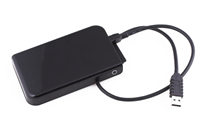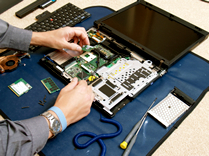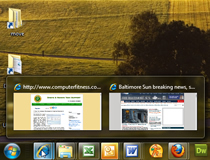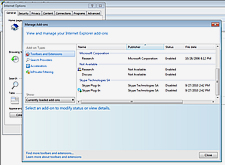Laptop computers that are available today often come equipped with hefty hard drives. Their capacity can range from 100GB to 899GB and can be even larger in desktop units. Because the amount of hard drive space available, the average computer user doesn’t really have to worry about overloading their hard drive. However for the folks with tons of software applications and hordes of movie, photos, and mp3 files it’s easy for their hard drives to still become flooded. Do you have too much stuff, is your computers hard drive approaching its full capacity?

When a computer’s hard drive begins to reach its maximum capacity it’s not uncommon for the computer to experience a major decrease in its speed. In addition to a drag in the speed, programs start to slow, freeze, and crash frequently. Additionally, you might also encounter reoccurring error messages and experience problems with new program installation. In a couple of our other blogs we detailed some methods of regaining your computers speed and reclaiming hard drive space. Described in the past blog articles were techniques that included managing the startup folder, running security software, clearing temporary internet files, performing a disk cleanup, and defragmenting the disk. Although these methods are extremely helpful in obtaining more space they will most likely be unable to assist with any hard drive that is above 85% capacity.
So what other options do you have?
Rather than purchasing a new computer, the two best economical options include upgrading your hard drive or purchasing an external hard drive. Although purchasing a new laptop hard drive might be cheaper than buying an external component it also comes with its own restrictions. Even though laptops make the access to the hard drive fairly accessible, the average computer user still may not have the knowledge to change out a hard drive. Attempting to… Read the rest
Tags: adding space, computer, external, external hard drive, hard drive
Posted in Desktop - Workstation, Storage | No Comments »
When using Facebook or any other social networking site, take full advantage of the provided Privacy Settings. Sites such as Facebook allow users to create profiles that contain private information and protect the posting personal comments. Now although the purpose of these sites is to network, communicate, and share your thoughts, that doesn’t mean everyone on the planet needs to know about them. Sure you might not mind if friends, family, and co-workers view the information that you supply to Facebook but what about complete strangers or employers? One of the best features of Facebook is that it lets you choose who you communicate with and who can see your information.
Following are recommendations on how to be protected using Facebooks privacy settings. Any of the following settings can be adjusted by logging into your Facebook account, navigating to the “Account” tab located in the upper right corner, and selecting the “privacy settings” option. Once the privacy settings page opens there are two main menus the “Connecting on Facebook” and “Sharing on Facebook” which can be customized to a users privacy preference. to be protected using Facebooks privacy settings. Any of the following settings can be adjusted by logging into your Facebook account, navigating to the “Account” tab located in the upper right corner, and selecting the “privacy settings” option. Once the privacy settings page opens there are two main menus the “Connecting on Facebook” and “Sharing on Facebook” which can be customized to a users privacy preference.
- Connecting on Facebook:
It is important to decide what people see before being friended. Facebook gives you the option to choose what information people see when searching for you and also gives you the choice to remove yourself completely from the search. A user can choose to share everything or nothing depending on their preference. Even if a user chooses to remain hidden from Facebook searches, they can still possibly be found by friends of friends, meaning when an individual sees you on one of their friend’s Friend Lists, they can still send you a friend request.
For safety reasons it is recommended that we customize our “Connecting on Facebook Settings” to share only the details we want to. On this menu a Facebook user can adjust whether anyone, friends, or friends of friends can
… Read the rest
Tags: Facebook, facebook settings, friend, post, privacy, privacy settings, settings, user
Posted in Social Networking | No Comments »
 For most of us we use computers because they make mundane tasks easier and we typically don’t think twice or concerned about how they are able to accomplish all that they do. Have you ever wondered what makes your computer tick? It would be helpful to be aware of the basic components that make up your computer. Whether it is to understand a sales person, identify a problem, or for a general understanding, knowing the basics about your computer can be very useful. For most of us we use computers because they make mundane tasks easier and we typically don’t think twice or concerned about how they are able to accomplish all that they do. Have you ever wondered what makes your computer tick? It would be helpful to be aware of the basic components that make up your computer. Whether it is to understand a sales person, identify a problem, or for a general understanding, knowing the basics about your computer can be very useful.
You probably know that your computer is made up of both hardware and software. Software is the programming that tells the computer what to do, how to do it, and which devices to use. The following are hardware devices located in your computer.
#1 – CPU
A CPU or Central Processing Unit is the processor or brain of your computer. This small device is the most important component of your computer. It understands the programs, receives instructions from the user, and delivers the results.
#2 – RAM
Random Access Memory or Computer Memory enables space for the computer to read and write temporary data. The data that is stored in the RAM is only available to the CPU while the computer is running and once the computer is turned off the data being stored in RAM will be cleared.
#3 – Hard Drive
The hard drive is the storage center of your computer. It keeps the contents of your desktop and is accessed by RAM. The RAM displays the information while the hard drive stores it.
#4 – Video Card and Sound Card
These cards have their own RAM and although it is this RAM that holds the data you need to hear or see, it is the video and… Read the rest
Tags: component, components, computer, computer devices, hard drive, Software
Posted in Hardware Overview, PC, PC Maintenance, Software | 1 Comment »
 Hello everyone, this is Dustin and I am back to help you with recapturing your computers speed. Hello everyone, this is Dustin and I am back to help you with recapturing your computers speed.
Have you experienced a decline in your computers speed or are you un-happy with the speed of your system? At some time or another we all have endured a slow startup, encountered simple tasks that have taken way too long, or suffered with speeds less than what we have come expect from our machines. In an attempt to salvage the fast processing speed that you may once possessed here are some simple methods that will help you regain and maintain speeds that you can appreciate.
- Check your security software- Run antivirus, and anti spyware scans!
- Using programs like McAfee Protection Software or Norton Security programs can identify and eliminate threats that can cause your equipment to run slower. These threats can infect your system causing harmful damage to your data and take up precious resources on your hard drive.
- Manage your startup folder- Eliminate the programs that are not needed!
- The start up folder contains files of any programs that you or software manufacturers have designated to start up automatically when your computer is first initializing. They can often drain the performance of your computer and this folder should only include the programs that you will be using immediately or those important to your computers operations.
- In order to fine-tune the startup folder you will need to access the system configuration folder. This can be done by expanding the Start menu, Clicking Run and then typing MSCONFIG. (Windows 7 uses the Search application instead of RUN.) Once the Configuration window appears click the Startup tab and carefully select the programs that you are positive that you do not need for startup. Save and exit, restarting your computer
… Read the rest
Tags: computer, computer running slower, computer speed, hard drive, program
Posted in Desktop - Workstation, PC Maintenance | 1 Comment »

Hello, Dustin back with some useful tips to assist you in creating a strong password. How confident are you with the strength of your current passwords?
Some of the elements of a strong password may appear to be common sense but be often overlooked. Most applications, resources or tools at your disposal require password protections that should not be taken for granted regardless of the level of importance that the information offers.
Passwords are for your safety and even if the information that is being protected is not detrimental, in the hands of criminals this resource could be utilized in an effective manner. It is more than likely that if a password is required the information is important and for your eyes only. Exercise the following steps to ensure that your information is safe and sheltered from outside users with a strong password.
- The longer the better: A strong password should utilize 10 or more characters.
- Variation Matters: Mix it up! Don’t use repetitive characters or common sequences.
- Add Complexity: By adding numbers, symbols, and various upper and lower case styles will greatly increase the protection of your password.
- Take advantage of the full keyboard: Avoid using familiar character groupings or letters and numbers found in the same row (example: qwerty123). Branch out using the full keyboard and select characters that have some distance between them.
Here is a Helpful method for creating a password:
- Create or think of a saying that is familiar to you,
- Select a letter position of each word, for example the first, second or last letter in each word, use this to create a row of letters,
- Add a couple numbers that you can easily remember,
- Add a symbol if allowed,
- Select 1 or more letters and capitalize it,
Example:… Read the rest
Tags: Information Security, password, passwords, strong
Posted in Desktop - Workstation, Information Security | No Comments »
 10 Tips to Help Keep Your Data Protected 10 Tips to Help Keep Your Data Protected
Hey everyone I’m Dustin, welcome back to our blog.
Worried about your information going out across the World Wide Web, continue reading to learn how you can get protected against loss of data, data theft, and data corruption.
- Physical Protection: Passwords, firewalls, and virus scanning are great but please don’t forget the basics. Keep your computer physically locked up or only leave it where you know for a fact that it will be safe. Even people you know can access your computer and bring unwanted problems if you give them the chance. Devices like security cables and alarms can be used but are not full proof. Making a note of the computer’s serial number can also be helpful if a theft does occur and needs to be reported. (Computer Protection Devices)
- Don’t be naïve not everyone is nice: Don’t give out your personal information to people you don’t know, it’s not a normal for strangers to ask for your address or birthday when you first meet them. Don’t provide too much information to social networking sites.
- Use Antivirus and Spyware programs: Using good Antivirus software is not enough anymore. New malicious programs are created and discovered every day so it is important that you not only have Antivirus software but that you keep it up to date as well. Antivirus programs scan, track, and remove any problems from your hard drive. Like Antivirus software a spyware program can detect and eliminate any spyware that has made a home on your hard drive. Many Antivirus programs do have anti-Spyware included, if yours does not, you will need to install a separate program for Spyware. Spyware can often track your web usage, violate your privacy, add unwanted features, and take up your computer usage for its own purpose. (Learn
… Read the rest
Tags: Firewall, Information Security, Software, strong password
Posted in Information Security, Mac and PC, PC, PC Maintenance | No Comments »
Hey everyone! Dustin here, welcome to our blog.
Many of us have already seen the Windows 7 advertisements but have continued to utilize previous operating systems. Are you still holding out on the windows 7 upgrade?
Here are 5 reasons why you should not wait any longer. Updating your operating system is crucial for both the security as well as usability features.
Occasionally an operating system may appear to take a few steps in the wrong direction but Win dows 7 is certainly not one of them. As operating systems continue to advance the latest versions are able to add features, especially those learned from previous versions short comings. The following key features generate both increased security as well as usability for users. As operating systems go Windows 7 is Fantastic! dows 7 is certainly not one of them. As operating systems continue to advance the latest versions are able to add features, especially those learned from previous versions short comings. The following key features generate both increased security as well as usability for users. As operating systems go Windows 7 is Fantastic!
1) The Smart Design
The Windows 7 task bar immediately catches the user’s attention. The new task bar has a better looking design than previous versions and its functionality is also unmatched.
The Windows 7 Live Task Bar Preview allows users to catch a glance at their open applications without having the window selected. Hovering over an icon in the task bar creates a window that shows what is going on in each open application. Preview may be the wrong name since within these windows users can now play, pause, or close the applications. In previous OS versions the preview window was strictly a quick snapshot, but with Windows 7 those days are long gone.
Rearrange your taskbar, this time around the tabs located on the task bar can be organized and relocated in an order that is more desirable to the individual users. Rather than opening and closing applications in the order you want them to appear in the task bar they can now easily be rearranged by simply dragging the icons. The task bar now permits users to pin… Read the rest
Tags: Operating Systems, task bar, Windows, Windows 7
Posted in Desktop - Workstation, Operating Systems, PC, Software, Windows | 1 Comment »
 Hey everyone! This is Dustin and welcome to our weblog. Hey everyone! This is Dustin and welcome to our weblog.
If you’re like me then you probably don’t like to fall victim to a slow Internet Explorer. By using Internet Explorer we are able to access tons of information on the Internet. However, Internet Explorer can often get bogged down by slow data transfers.
Whether you are currently having problems with slow browser speeds, have experienced slow speeds in the past, or even if you want to be prepared for potential future problems here are 7 quick and simple tips that will help you on your way to establishing a quicker and healthier Internet Explorer.
1. Limit Add-ons, Accelerators, and Providers
Customize your browser by limiting the unnecessary add-ons running in Internet Explorer. Leave what you use regularly and disable those add-ons that you don’t use. To do this access the Tools drop down from the file menu and select “Manage Add-ons” (the list is on the right for Toolbars and Extensions). From this menu also click on “Accelerators” and you should also disable any unneeded Accelerators. Similarly click on “Search Providers and disable those that are no longer useful to your Internet browsing (for example I disabled Bing as I am not using it).
2. Clearing Away Junk
It is also important to delete your browsing history and temporary Internet files once a week or once a month. By doing this you are clearing away junk and gaining space and speed that will now be available for more important tasks.
3. Make More Room
Increasing the amount of space available for Internet data storage can be done on this menu also by adjusting the cache disk space option. Increasing the cache enables your computer to remember images this way on the next visit your computer does not have to devote so many resources to download them again. To do this click Tools, then “Internet Options” , under the second… Read the rest
Tags: internet explorer, internet options, pop-up blocker
Posted in Browser Modifications | 2 Comments »
November 23, 2010 by josh
 Hey, everyone, Josh from Computer Fitness back with another award-winning article to help you with your computer conundrums. Hey, everyone, Josh from Computer Fitness back with another award-winning article to help you with your computer conundrums.
Sometimes bad things happen to your PC. It happens to the best of us. Something goes wrong and before you know it, it’s time to break out the dusty restore discs. Well, there are ways around having to burn your system to the ground. One of these ways, built into the Windows operating system, is the Restore Point software.
Restore Point sets up places in your system where you can revert back to in case of errors. This feature is great for several reasons. First of all, you can choose when to set these. By doing this, you can schedule them or just have them automatically occur when you’re installing new programs. This is good in case the program or update does damage to your machine’s stability. You simply roll back to the start date and you’re good to go.
Another beneficial aspect of Restore Points is that they are usually safe in the case of a Windows failure. This is not to say that if your HDD breaks down, you can just use a Restore Point. Rather, you can sometimes use them in conjunction with a system restore disc or copy of Windows to get back to where you were from an OS standpoint.
Now, the points are not to be confused with complete system backups. You’ll need either third-party software or Windows 7 Ultimate to do that. However, the Restore Points do allow for users to revert to previous versions of the Registry and various Windows aspects.
More Info
Microsoft Windows System Restore
What is Windows System Restore?
What are the system recovery options in Windows 7?
-Josh
ComputerFitness
Tags: pc, Recovery, Safety, System Restore, Windows, Windows 7
Posted in PC | No Comments »
November 19, 2010 by josh
Hey, everyone, Josh from Computer Fitness back with another award-winning article to help you with your computer conundrums.
Wifi has been around for years now. It has grown and expanded into something that is a part of our daily lives. For years, Wireless G was the standard by which all wireless devices were designed. However, recently, Wireless N has taken over as the new goal for developers and technological enthusiasts. Now, a lot of websites and products will talk about Wireless N and how you need it desperately. Here are some things you should know about Wireless N before you proceed.
It Is Faster than Wireless-G
Now, Wireless N is definitely faster than Wireless G. You can send enormous amounts of data over a Wireless N network in a fraction of the time it would take on a G network. This is great for streaming video and audio inside of your home or office, as well as moving around files for backup.
Requires a New WiFi Card
Your old G card won’t cut it here. This is a new wireless standard and, as such, requires new hardware. Don’t you just love technology? So before someone at a big box retail store tells you that you need a Wireless N router, account for the necessary new hardware you’ll have to buy as well.
There is No Internet Connection Fast Enough
While N is faster than G, there is currently no Internet service out there that can match the speeds. At most, your local ISP (Internet Service Provider) could offer something that uses 10% of your Wire
Less N connection. So remember, you don’t NEED Wireless N unless you’re moving data around your house a lot. A good example here is streaming video wirelessly from a desktop to a TV.
Additional Information
Reviews: CNET PCmag
-Josh
ComputerFitness
Tags: Networking, pc, Setup, WiFi, Wireless, Wireless G, Wireless N
Posted in Local Area Network (LAN), Networking | No Comments »
|













 Hey, everyone, Josh from Computer Fitness back with another award-winning article to help you with your computer conundrums.
Hey, everyone, Josh from Computer Fitness back with another award-winning article to help you with your computer conundrums.

